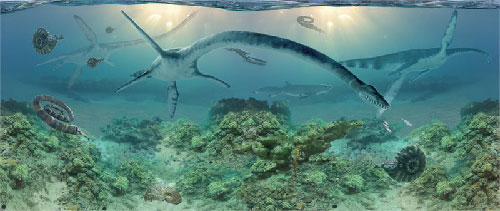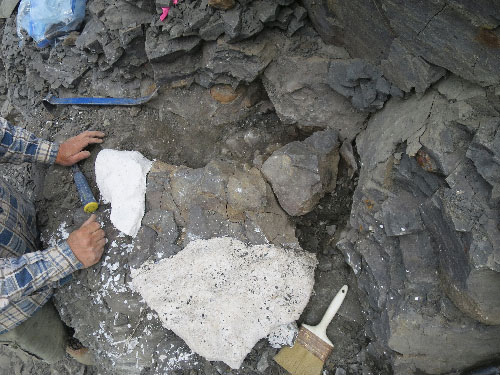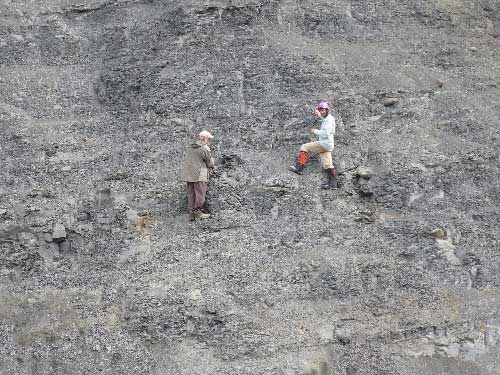
First elasmosaur specimen excavated in AlaskaBy THERESA BAKKER July 22, 2015
This painting of life in a Cretaceous sea by Anchorage artist James Havens depicts elasmosaurs. Havens is working with earth sciences curator Pat Druckenmiller to realistically interpret ancient life forms.
Over the past few years, Curvin Metzler, an Anchorage-based fossil collector, found several vertebrae from the skeleton eroding out of a bluff. He’d been hiking in the area for 25 years and this was the first vertebrate fossil he found there. When Metzler, Druckenmiller and two others visited the site in June, they were able to identify the source of the bones in the hillside and collect a good portion of the skeleton.
An articulated portion of the spine extends into the hill to the right of the small plaster jacket. The larger plaster jacket contains part of the elasmosaur’s scapula.
Even though the new elasmosaur is a first for the state, Druckenmiller has collected plesiosaurs from all over western North American and is one of the world’s marine reptile fossil experts. In 2010, he led a team that collected a nearly complete elasmosaur skeleton from Montana, which is currently on display as part of the museum’s “Expedition Alaska: Dinosaurs” exhibit in Fairbanks. “I was really excited the first time Curvin showed me one of its bones,” he said. “I recognized it as a vertebra from the base of the animal’s neck and wanted to visit the site to see if we could find more. Based on the size of the bones we excavated, the animal should be at least 25 feet long.”
Curvin Metzler (left), who discovered the elasmosaur fossil, and UAMN earth sciences curator Patrick Druckenmiller examine the spot where bones were found sticking out of the cliff in the Talkeetna Mountains.
Metzler stressed the value of this fossil. “Something like this belongs in a museum where researchers can learn more about this group of animals.” Plesiosaurs are one of three types of ancient marine reptiles discovered in Alaska. Specimens of ichthyosaurs and thalattosaurs have been previously collected by the museum’s earth sciences crew. Some of those are also on display as part of the museum’s special exhibit through summer 2016.
On the Web:
This article is provided as a public service by the University of Alaska Museum of the North . Theresa Bakker [tabakker@alaska.edu] is an information writer for the University.
|
||


